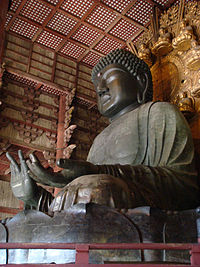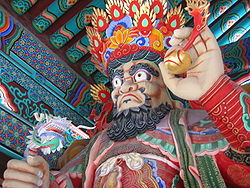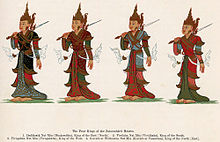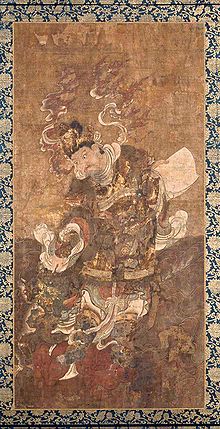- Four Heavenly Kings
-
This article is about Buddhist gods. For other uses, see Four Heavenly Kings (disambiguation).
In the Buddhist faith, the Four Heavenly Kings are four gods, each of whom watches over one cardinal direction of the world.
The Kings are collectively named as follows:
Language Written form Romanization Translation Sanskrit चतुर्महाराज caturmahārāja Four Kings Lokapāla Guardians of the world Burmese စတုလောကပါလ
စတုမဟာရာဇ်နတ်IPA: [sətṵ lɔ́ka̰ pàla̰]
IPA: [sətṵ məhà ɹɪʔ naʔ]Four worldly guardians
Four Great King NatsChinese 天王 Tiānwáng Heavenly kings 四天王 Sì Tiānwáng Four heavenly kings 四大天王 Sì Da Tiānwáng Four great heavenly kings Korean 천왕 Cheonwang Heavenly kings 사천왕 Sacheonwang Four heavenly kings Japanese 四天王 Shitennō Four heavenly kings Vietnamese 四天王 Tứ Thiên Vương Four heavenly kings Tibetan rgyal chen bzhi Four great kings Mongolian Махаранз maharanja (Four) Great kings Thai จาตุมหาราชา chatumaharaja Four great kings จาตุโลกบาล chatulokkaban Four Guardians of the world They currently live in the Cāturmahārājika heaven (Pāli Cātummahārājika, "Of the Four Great Kings") on the lower slopes of Mount Sumeru, which is the lowest of the six worlds of the devas of the Kāmadhātu. They are the protectors of the world and fighters of evil, each able to command a legion of supernatural creatures to protect the Dharma. They are:
Sanskrit romanization Vaiśravaṇa (Kubera) Virūḍhaka Dhṛtarāṣṭra Virūpākṣa Sanskrit Devanagari वैश्रवण (कुबेर) विरूढक धृतराष्ट्र विरूपाक्ष Pāli romanization Vessavaṇa (Kuvera) Virūḷhaka Dhataraṭṭha Virūpakkha Pāli Devanagari वेस्सवण (कुवेर) विरूळ्हक धतरट्ठ विरूपक्ख Meaning He who hears everything He who enlarges He who maintains the state He who sees all Patron of Growth Watcher of the Lands Burmese ကုဝေရ ဝိရဠက ဓတရဌ ဝိရုပက္ခ Traditional Chinese 多聞天王 增長天王 持國天王 廣目天王 毗沙門天 留博叉天 多羅吒天 毗琉璃天 Simplified Chinese 多闻天王 增长天王 持国天王 广目天王 毗沙门天 留博叉天 多罗吒天 毗琉璃天 Hanyu Pinyin Duō Wén Tiānwáng Zēng Zhǎng Tiānwáng Chí Guó Tiānwáng Guăng Mù Tiānwáng hangul 다문천왕 증장천왕 지국천왕 광목천왕 Romanized Korean Damun-cheonwang Jeungjang-cheonwang Jiguk-cheonwang Gwangmok-cheonwang kanji 多聞天 (毘沙門天) 増長天 持国天 広目天 治国天 Hepburn romanization Tamon-ten (Bishamon-ten) Zōjō-ten Jikoku-ten Kōmoku-ten Zōchō-ten Sino-Vietnamese Đa Văn Thiên Tăng Trưởng Thiên Trì Quốc Thiên Quảng Mộc Thiên Tibetan romanization rnam.thos.sras (Namthöse) 'phags.skyes.po (Phakyepo) yul.'khor.srung (Yülkhorsung) spyan.mi.bzang (Chenmizang) Thai ท้าวกุเวร ท้าววิรุฬหก ท้าวธตรัฐ ท้าววิรูปักษ์ เวสวัณ,เวสสุวัณ,เวสสุวรรณ Thai romanization Thao Kuwen Thao Virunhok Thao Thatarot Thao Virupak Vessavan Color Yellow Red Green White Symbol Umbrella Sword Pipa Serpent Mongoose pagoda stupa pearl Followers Yakṣas Kumbhāṇḍas Gandharvas Nāgas Direction North South East West Further associations between the four directions and elements, seasons, planets, animals, internal organs, etc. can be found at Five elements (Chinese philosophy). Note, however, that the colors assigned to the Four Heavenly Kings represent an independent tradition and do not correspond to the traditional Chinese association of colors and directions.
All four serve Śakra, the lord of the devas of Trāyastriṃśa. On the 8th, 14th and 15th days of each lunar month, the Four Heavenly Kings either send out messengers or go themselves to see how virtue and morality are faring in the world of men. Then they report upon the state of affairs to the assembly of the Trāyastriṃśa devas.
On the orders of Śakra, the four kings and their retinues stand guard to protect Trāyastriṃśa from another attack by the Asuras, which once threatened to destroy the kingdom of the devas. They are also vowed to protect the Buddha, the Dharma, and the Buddha's followers from danger.
According to Vasubandhu, devas born in the Cāturmahārājika heaven are 1/4 of a krośa in height (about 750 feet tall). They also have a five-hundred year lifespan, of which each day is equivalent to 50 years in our world; thus their total lifespan amounts to about nine million years (other sources say 90,000 years).
In Chinese they are known collectively as "Fēng Tiáo Yǔ Shùn" (風調雨順 / 风调雨顺), which translates into "Good Climate". This mnemonic reminds one of the symbols the Heavenly Kings carry. For instance, "Fēng" sounds like the Chinese word for "edge" (鋒 / 锋), hence the corresponding symbol is a sword. "Tiáo" sounds like "Tune", hence the corresponding symbol is a musical instrument. "Yǔ" means "rain", hence the corresponding symbol is an umbrella. "Shùn" refers to the symbol of a crimson dragon (赤龍 / 赤龙).
These symbols also link the deities to their followers; for instance, the nāgas, magical creatures who can change form between human and serpent, are led by Virūpākṣa, represented by a snake; the gandharvas are celestial musicians, led by Dhṛtarāṣṭra, represented with a lute. The umbrella was a symbol of regal sovereignty in ancient India, and the sword is a symbol of martial prowess. Vaiśravaṇa's mongoose, which ejects jewels from its mouth, is said to represent generosity in opposition to greed.
Tamon-ten (north)
Kōmoku-ten (west)
Heavenly Kings
(Japanese)Jikoku-ten (east)
Zōjō-ten (south)
See also
References
- Chaudhuri, Saroj Kumar. Hindu Gods and Goddesses in Japan. New Delhi: Vedams eBooks (P) Ltd., 2003. ISBN 8179360091.
- Nakamura, Hajime. Japan and Indian Asia: Their Cultural Relations in the Past and Present. Calcutta: Firma K.L. Mukhopadhyay, 1961. Pp. 1–31.
- Potter, Karl H., ed. The Encyclopedia of Indian Philosophies, volume 9. Delhi: Motilal Banarsidass, 1970–. ISBN 8120819683, ISBN 8120803078 (set).
- Thakur, Upendra. India and Japan: A Study in Interaction During 5th cent.–14th cent. A.D.. New Delhi: Abhinav Publications, 1992. ISBN 8170172896. Pp. 27–41.
Chinese Buddhist Pantheon Buddhas: Deities:
Deities:Four Heavenly Kings (Sì Tiānwáng) | Sangharama (Qíelán) | Skanda (Wéituó) | Yama (Yán Wáng) | Jìgōng |
Sudhana (Shan Cai) | Nagakanya (Long Nü) | Marici (Mólìzhītiān)Mahākāśyapa | Ānanda | Moggallāna | Bodhidharma (Dámó) | An Shigao | Xuánzàng | Fǎxiǎn | Yìjìng | Shàn Dào | Huìguǒ | Emperor Ming | Emperor Wu | Eighteen LuohansJapanese Buddhist Pantheon  Buddhas (Nyorai-bu):Bodhisattvas (Bosatsu-bu):Vajraparamita (Kongō-Haramitsu) | Vajrasattva (Kongosatta) | Maitreya (Miroku) | Avalokitesvara (Kannon) | Samantabhadra (Fugen) | Manjusri (Monju) | Mahapratisara (Daizuigu) | Ksitigarbha (Jizo) | Akasagarbha (Kokuzo) | Mahasthamaprapta (Seishi)Wisdom Kings (Myōō-bu)Five Wisdom Kings | Acala (Fudo-Myoo) | Rāgarāja (Aizen-Myoo) | Ucchusma (Ususama) | Hayagriva (Bato Kannon) | Mahamayuri (Kujaku-Myoo) | Yamantaka (Daiitoku)Deities (Ten-bu):Shitennō | Marici (Marishi-ten) | Mahakala (Daikokuten) | Saraswati (Benzaiten) | Brahma (Bonten) | Hotei | Jurōjin | Fukurokuju | Vaisravana (Bishamonten) | Ebisu | Ugajincircumstantial appearances (Suijakushin-bu):Izuna Gongen | Atago Gongen | Konpira DaigongenReligious men (Kōsō・Soshi-bu):Bodhidharma | Prince Shōtoku | Kūkai | Saichō | Dōgen Kigen |Honen | Shinran | Nichiren | Sixteen Arhats
Buddhas (Nyorai-bu):Bodhisattvas (Bosatsu-bu):Vajraparamita (Kongō-Haramitsu) | Vajrasattva (Kongosatta) | Maitreya (Miroku) | Avalokitesvara (Kannon) | Samantabhadra (Fugen) | Manjusri (Monju) | Mahapratisara (Daizuigu) | Ksitigarbha (Jizo) | Akasagarbha (Kokuzo) | Mahasthamaprapta (Seishi)Wisdom Kings (Myōō-bu)Five Wisdom Kings | Acala (Fudo-Myoo) | Rāgarāja (Aizen-Myoo) | Ucchusma (Ususama) | Hayagriva (Bato Kannon) | Mahamayuri (Kujaku-Myoo) | Yamantaka (Daiitoku)Deities (Ten-bu):Shitennō | Marici (Marishi-ten) | Mahakala (Daikokuten) | Saraswati (Benzaiten) | Brahma (Bonten) | Hotei | Jurōjin | Fukurokuju | Vaisravana (Bishamonten) | Ebisu | Ugajincircumstantial appearances (Suijakushin-bu):Izuna Gongen | Atago Gongen | Konpira DaigongenReligious men (Kōsō・Soshi-bu):Bodhidharma | Prince Shōtoku | Kūkai | Saichō | Dōgen Kigen |Honen | Shinran | Nichiren | Sixteen ArhatsBuddhism Categories:- Buddhist cosmology
- Lokapalas
Wikimedia Foundation. 2010.








